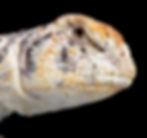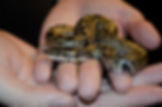
Chinese Water Dragon Care Guide
Chinese Water Dragon Care Tips: Everything You Need To Know About Your Pet Chinese Water Dragon
Chinese Water Dragons have a lifespan of 14-16 years and grow to be 2-3 feet long, making them one of the largest lizards you can keep as a pet.
The Natural History of Chinese Water Dragons
Originally, Chinese Water Dragons (Physignathus cocincinus) were found in southern China, Thailand, Cambodia and Vietnam. The pet dragons that most people keep today, however, are almost exclusively captive bred. Breeding in captivity for domestication helps keep the wild population untouched and also ensures that the pets people take home are bred specifically for handling domestic life.


How to Care for Your Pet Chinese Water Dragon
Chinese Water Dragon Tanks and Housing
Chinese water dragons are tree dwelling, so you’ll need a tank with a large amount of vertical space. Adult dragons should be kept in an enclosure that is at least 4 to 6-feet high and 3 to 4-feet long and wide. Be sure to fill the tank with branches and vines that your pet lizard can climb on.
If you choose a glass or plexiglass cage, it will be easier to keep the environment humid. Be sure to use a screen top, however, to allow for proper ventilation. Adding in running water, misting systems and/or drip systems can also help you maintain proper humidity and keep your dragon properly hydrated. Near the top of the cage, create a comfy place for your water dragon to bask under its heat bulb. You also need a large water bowl that provides ample space for your dragon to fully submerge.
How Can You Clean Your Water Dragon’s Cage?
A clean, moisture-rich cage is important to the health of your Chinese Water Dragon and you should set aside a few minutes each day to change your pet’s water and spot clean. Bacteria and fungus spread quickly in the moist enclosure so you want to stay on top of the cleaning. Do a thorough clean once a week, wiping down the plexiglass or glass surfaces and replacing the moss.
Which Substrate Is Best for My Chinese Water Dragon?
When using a glass enclosure for Chinese Water Dragons, make sure to place something dark around the bottom few inches of the glass. Water dragons don’t recognize the glass and they will rub against it to try to get through to the other side. Placing an apparent obstruction in that area can prevent damage to the end of their nose.
We don’t recommend using loose substrate because it can grow mold easily and harbor bacteria. This can cause health issues in your reptile. Instead, place paper towels or vinyl flooring on the bottom of your tank. This will also make it easier to monitor your dragon’s fecal output and ensure they are passing healthy stools. Sphagnum moss can be added on top to help maintain humidity.
Hot & Steamy: Providing the Right Climate for Your Chinese Water Dragon
Chinese Water Dragons are well adapted to life in warm, humid environments. Keep the humidity around 80%. You’ll definitely want to invest in a reliable hygrometer so you can easily monitor humidity levels.
You’ll also need a UVB light and heat source above the basking area. A ceramic heat emitter or basking bulb can be used for heat. Avoid red or blue heat bulbs as they can be harmful to your dragon’s eyes.
Keep in mind that glass or very fine mesh will block the UV light, so make sure that the basking area allows the light to enter the enclosure. A linear UVB bulb is also much more beneficial than a coil UVB, as it covers a larger surface area of the tank. We recommend changing the UVB bulb every 6 months as the amount emitted diminishes overtime. Read more tips for choosing the right light source for your reptile.
During the day, the temperature in the enclosure should be 80-88° F and 95° F in the basking area. This can be achieved with a 100w or 150w basking bulb placed approximately 8-10 inches above your basking platform depending on the size of your tank. A basking lamp with a thermostat will help regulate the temperature in the enclosure. To prevent burns, your pet should NOT be able to come into direct contact with the heat source. At night, the UVB light and heat bulb can be turned off as long as the temperature does not drop below 65 degrees. If your tank is getting too cold, a ceramic heat emitter can be left on at night.
You also want to provide your pet with a designated cool area so that your water dragon can thermoregulate itself. Keep in mind that because Chinese Water Dragons require large enclosures, you will probably need two or more bulbs to maintain the proper temperatures.
Your Chinese Water Dragon’s Third “Eye”
See that little black dot on the top of your dragon’s head? Don’t pick at it! Dragons have a primitive third “eye” or parietal “eye.” This organ is photoreceptive, meaning that it does not “see” clear images. It is believed, however, that lizards can use their parietal eye to discern the absence and presence of light. The third eye helps regulate their circadian rhythm as well as the hormones produced for thermoregulation.
Chinese Water Dragon Diet & Nutrition
What Do Chinese Water Dragons Eat?
Chinese Water Dragons are omnivores, so they’ll need a mix of live insects and vegetables. You want to provide your pet with fresh insects every day as this makes up 85% of their diet, with vegetables making up the other 15%. Variety is key! Crickets, mealworms, waxworms, and dubia roaches are great interchangeable staples to incorporate in your dragon’s diet
PRO TIP: Gutloading and dusting with calcium is essential to the health of your dragon. Gutload the insects at least 24 hours prior by feeding them a variety of dark leafy greens, vegetables and fruits. Dust the insects with calcium before offering them to your dragon. Calcium without D3 should be dusted daily, calcium with D3 should be dusted once a week and a multivitamin can be dusted 1-2x a month.
What Vegetables Can I Feed My Chinese Water Dragon?
15% of your pet’s diet should come from vegetables. We recommend providing a mix of dandelion greens, kale, romaine lettuce, bell peppers, bok choy and even squash. Chop the vegetables into very small pieces before offering them to your pet. Click here for a list of leafy greens that are high in vitamin A and calcium and are great to offer to your dragon.
IMPORTANT: Avoid avocado as it can be toxic to your reptile.
Remember that you should never give dog, cat or other animal food to your Chinese Water Dragon. Stick specifically to the foods listed above in order to ensure your pet has proper nutrition and stays healthy. Feeding your dragon the wrong diet can lead to health issues.


What Medical Care Does My Pet Chinese Water Dragon Need?
Recommended Checkups for a Chinese Water Dragon
When you first take home your Water Dragon, we recommend having a specialized reptile vet examine your new pet. We also recommend scheduling an annual physical exam (including fecal and blood work) to ensure a long and healthy life, the same way you would take a dog or a cat to the vet!
Common Concerns With Chinese Water Dragons
As an exotic species, Chinese Water Dragons can encounter a number of health risks that may not be easy to spot for a first-time owner. Reptiles are also very good at hiding their symptoms until they have severely progressed. Sometimes, pets can have parasites or infections that they contracted before they came to live with you. These are commonly caused by overcrowding, travel or poor husbandry. If you see any sign of illness, you want to bring your pet in for treatment right away. Early treatment is essential.
Other common health issues that can arise include:
-
Metabolic bone disease
-
Abrasions on the nose or chin from rubbing glass
-
Upper respiratory infections
-
Skin infections
-
Retained shed
-
Impaction
If you think your pet may have a medical problem, it’s important to schedule an appointment right away.
How Can You Tell If Your Chinese Water Dragon Is Sick?
The following is a list of signs or symptoms that might indicate your Chinese Water Dragon is sick. If you observe these in your pet dragon, we recommend scheduling an appointment with a reptile vet nearby.
-
Lethargy
-
Abnormal skin discoloration
-
Stuck shed
-
Decreased appetite / anorexia
-
Decreased fecal production
-
Loose or runny stool
-
Open mouth breathing
-
Decreased use of limbs / bowing of limbs
-
Mouth abnormalities such as jaw misalignment, crusting around mouth, etc.
Emergencies
The following is a list of Chinese Water Dragon emergencies. If you witness these, seek medical care right away.
-
Overheating or burns
-
Falls from high surfaces
-
Broken bones (including the tail)
-
Impaction
-
Egg binding
-
Excessive head bobbing
-
Seizures or head tilt
Even if you aren’t sure if you’ve got an emergency on your hands, your safest bet is to contact your reptile veterinarian.
At Long Island Bird & Exotics, we are on-call for you and your pet. Contact us about your Chinese Water Dragon emergencies if you live in the NY area!












